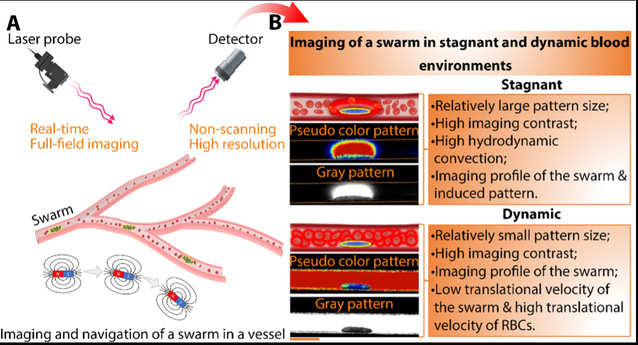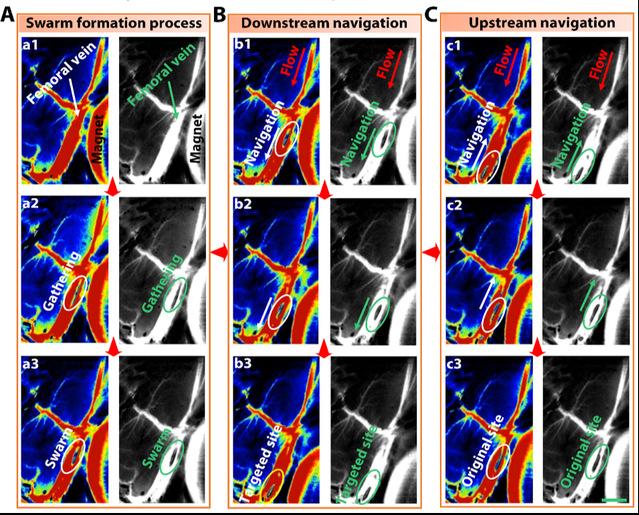Recently, Professor Wang Qianqian from the School of Mechanical Engineering at Southeast University, along with international collaborators, made significant progress in the field of microswarm manipulation. Their research findings, titled Tracking and navigation of a microswarm under laser speckle contrast imaging for targeted delivery, were published in the prestigious academic journal Science Robotics (Paper Link: https://www.science.org/doi/10.1126/scirobotics.adh1978).
Spontaneous collective behaviors in biological organisms, such as ant bridge construction, bacterial colony proliferation, and the movement of fish and bird flocks, serve as effective means for organisms to evade predators and seek benefits while avoiding harm. By studying the biomimetic behaviors of collective behaviors in nature, scientists have achieved cluster control of colloidal particles at the microscale through various control methods. Among them, magnetic microswarm in the biomedical field has shown tremendous potential applications, thanks to its superior active manipulation capability, enhanced imaging contrast, and controllable environmental adaptability.
Currently, achieving real-time localization and tracking of microclusters in the circulatory system remains challenging, with the following key issues awaiting resolution:
1. The rapid changes in blood flow disrupt the stability of microclusters, making it difficult to achieve controlled cluster motion.
2. There is a lack of high-precision real-time feedback strategies for the state of microclusters in real physiological environments, preventing timely adjustment of control parameters.
3. There is a lack of large-area imaging methods for instantaneously depicting complex vascular structures, hindering the long-distance navigation and tracking of microclusters.

Figure 1. Schematic diagram of real-time tracking and localization strategy for microclusters based on LSCI
Building on their previous work (Q. Wang et al., Science Advances, 2021, 7, eabe5914), Professor Wang Qianqian and her collaborators propose a strategy for real-time tracking and navigation of microclusters in stationary and flowing blood environments based on laser speckle contrast imaging (LSCI). This strategy utilizes Fe3O4@SiO2 nanoparticles as the basic building blocks of magnetic microclusters, controls the aggregation behavior of microclusters using a rotating magnetic field, and achieves cluster navigation close to the vessel wall. LSCI can monitor the interactions between microclusters and the surrounding environment in real time, and further analysis of image information enables real-time tracking and navigation of microclusters in complex vascular systems. The authors demonstrate the long-distance navigation capability of microclusters in real vascular environments using the human placenta as a model. The research results show that the cluster control and tracking strategy can achieve continuous navigation of clusters over a relatively long distance (approximately 400 mm) in the human placental vessels. In validation experiments using a live rat femoral vein model, microclusters maintained stable and intact states throughout the navigation process in both upstream and downstream directions, with no apparent particle loss, thanks to the effective control strategy. Additionally, the strong imaging contrast of microclusters in the femoral vein increased navigation accuracy and further improved delivery efficiency in vivo. Overall, magnetic microclusters guided by LSCI achieve real-time tracking and high-precision navigation in both in vitro and in vivo vascular environments, enabling quantitative assessment of the interactions between microclusters and blood environments. They can also achieve efficient delivery under high flow conditions (average flow rate of 55 mm/s). This study provides effective control strategies for active targeted delivery of micro/nanorobot clusters in the circulatory system, contributing to the development and clinical application of therapeutic platforms based on micro/nanorobotics.
Figure 2. Real-time tracking and navigation of microclusters in live experimental rodent vasculature
The paper features joint first authors, doctoral candidate Wang Qinglong from the Chinese University of Hong Kong and Professor Wang Qianqian from the School of Mechanical Engineering at Southeast University. Professor Wang Qianqian from Southeast University's School of Mechanical Engineering, Professor Yiu Ming Ip from the Chinese University of Hong Kong's Faculty of Medicine, and Professor Zhang Li from the Chinese University of Hong Kong's Department of Mechanical and Automation Engineering are listed as corresponding authors. This work is simultaneously included in the Science Robotics Special Issue on Magnetic Robots for Medical Applications and highlighted on the journal's homepage. Funding for this work was provided by the National Natural Science Foundation, the Basic Research Program of Jiangsu Province, and startup funding from Southeast University.

